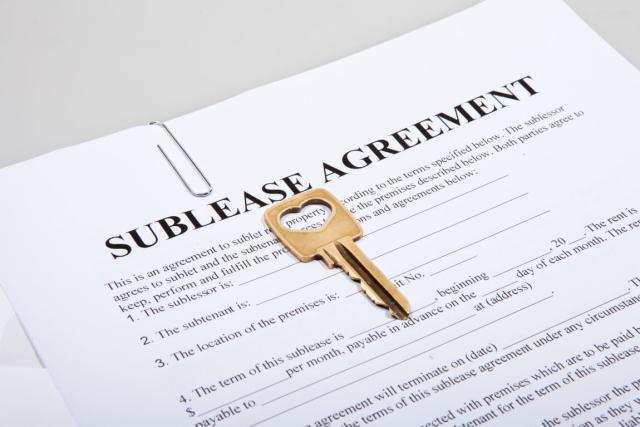You've finally landed the job of your dreams, doing the work you've always dreamed of doing for a great salary and amazing benefits. It would be perfect if it weren't 200 miles away and you didn't have a lease for the next six months. But wait: You could always sublet your apartment! Subletting has risks, but if done properly, moving out early without breaking your lease will be possible. This comprehensive guide will walk you through the ins and outs of subletting your apartment. We'll cover everything from understanding your lease terms to finding a trustworthy subtenant. Here are the steps you need to follow to make subletting your apartment a success.
Understanding Your Lease and Legalities
Before diving headfirst into the world of subletting, taking a good, hard look at your lease agreement is crucial. You see, this little document holds the keys to whether you can sublet your apartment or not. Often, landlords include a clause about subletting, and it's essential to understand what it says.
Get your landlord's permission
-
Read your lease to determine your subletting rights. If your landlord profusely forbids it, try to explain your situation in writing and negotiate a solution. You can offer to help your landlord find a new renter, although you are still responsible for the rent until a new lease is signed.
-
If subletting is permitted, get your landlord's permission in writing before moving on to the next step.
However, let's say your landlord doesn't agree, or you decide to proceed without permission. That's where things get sticky. You could be facing legal consequences, ranging from fines to eviction. Plus, it could damage your relationship with your landlord and affect future rental opportunities. And believe me, that's not a situation you want to find yourself in.
Finding the Right Subtenant
Subletting your property can be a convenient solution for various reasons, whether you're traveling, temporarily relocating, or seeking additional income. However, ensuring you find a trustworthy subtenant is crucial to safeguarding your property and maintaining a positive rental experience. Here are some tips to help you find the right subtenant:
-
Ask around your circle of friends and co-workers first. If you don't get a response, try posting an advertisement on social media websites.
-
Describe your apartment and the dates that it will be available, along with your contact information. You can try to advertise for the same rent you are paying but may have to reduce the rate if you have limited time.
-
Interview interested people. Take the time to conduct interviews with potential subtenants. This lets you gauge their personality, communication style, and compatibility with your rental property. Ask about their reasons for subletting, their expectations, and any concerns they may have. Open and honest communication from both parties can help establish a positive landlord-subtenant relationship.
Here are some questions to ask a potential subletter:
-
Where are you employed, and what is your monthly after-tax income?
-
Why are you seeking short-term housing?
-
How many people will be living in the apartment? Any children? Any pets?
-
Do you plan on having any social events or guests staying at the apartment?
Give the best potential sublet candidates a tour of the apartment. Answer their questions as honestly as possible and be candid about any problems. You don't want the subletter to back out in a month or two since you will be left to fill in the rent.
Drafting a Sublease Agreement
A sublease agreement is a legally binding contract between the original tenant (the sublessor) and a new tenant (the sublessee) who will temporarily occupy the rental property. This arrangement allows the sublessee to rent all or part of the property from the original tenant for a specified period while the original tenant retains responsibility for the lease with the landlord. Drafting a comprehensive sublease agreement is essential for clarifying the rights, responsibilities, and expectations of both parties involved in the subletting arrangement.
Tips for Drafting a Thorough and Legally Sound Sublease Agreement:
-
Even if you were lucky enough to have a friend take over your lease, you still need to have a written agreement. You can make one yourself, but this is not advisable unless you're a lawyer. The Internet Legal Research Group has a sublet form for every state. Print out the form for your state here. A professionally formatted version of the form is available for a fee.
-
Include Basic Information: Identify the parties involved in the sublease agreement, including the names and contact information of the sublessor and sublessee and the address of the rental property.
-
Specify Sublease Terms: Clearly outline the duration of the sublease, including the start and end dates. Specify whether the sublease covers the entire rental property or a specific portion, such as a room or unit.
-
Define Rent and Payment Terms: Detail the rent amount, payment due date, and acceptable payment methods. Include any late fees or penalties for missed payments and procedures for rent increases during the sublease term.
-
Address Security Deposit: Specify the amount of the security deposit required from the sublessee and outline the conditions under which it will be refunded at the end of the sublease term. Clearly state any deductions that may be made for damages beyond normal wear and tear. For example, if the subletter puts a hole in the wall, are they responsible for the security deposit? If you don't address it, the money will come out of your pocket.
-
Outline Responsibilities: Clearly define the responsibilities of both the sublessor and sublessee during the sublease term. This may include maintenance duties, utilities, parking arrangements, and adherence to any rules or regulations set forth by the original lease agreement.
-
Include Landlord Consent: If required by the original lease agreement, include provisions requiring the sublessee to obtain written consent from the landlord before occupying the rental property.
-
Consult Legal Counsel: Consider consulting with a legal professional experienced in real estate law to ensure that the sublease agreement complies with applicable laws and adequately protects the interests of both parties.
-
Depending on the terms of your lease and state laws, you may have tenant's rights over the subletter. This means you can evict the person if they do not pay rent or in any other way violates the terms of the written agreement. Explain this to the subletter so that there is no confusion later.
By following these tips and drafting a thorough sublease agreement, the sublessor and sublessee can confidently enter the subletting arrangement, knowing that their rights and obligations are clearly defined and legally enforceable.
Subletting your apartment can be a practical solution for various circumstances, whether it's to mitigate financial burdens, accommodate temporary lifestyle changes, or simply maximize the utility of your living space. By following the steps outlined in this guide, you can confidently navigate the process and ensure a smooth and successful subletting experience. Remember to prioritize communication, legality, and clarity throughout the process to protect both yourself and your subtenant. With careful planning and consideration, subletting can be a mutually beneficial arrangement for all parties involved, allowing you to maintain flexibility while ensuring your rental is in responsible hands.






